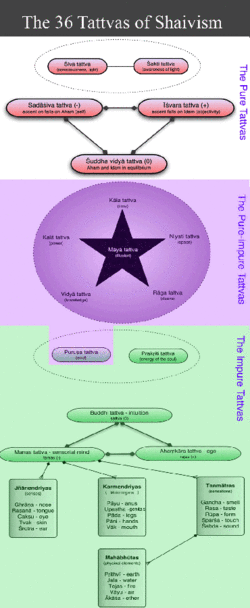Parameshwara (god)
Topic: Philosophy
 From HandWiki - Reading time: 4 min
From HandWiki - Reading time: 4 min
Parameshvara (IAST: Parameśvara, Sanskrit: परमेश्वर), also rendered Parashiva and Sadashiva, is an epithet of the Hindu destroyer deity, Shiva. The term usually indicates the position of Shiva as the Supreme being and Supreme Reality in the tradition of Shaivism.[1][2][3] Parameshvara is the ultimate and highest reality that eternally pervades all matter for Shaivas, the devotees of Shiva.[4] He is regarded by devotees to be totality itself, controlling the triple forces of creation, preservation, and destruction.[5]
Etymology
The word is a compound of the Sanskrit words परम meaning 'Supreme' and ईश्वर meaning 'Lord'. Thus Parameshvara literally means 'highest supreme ruler'. Similarly, the word Paramashiva (Parama + Shiva) means 'Supreme shiva'. These two words are simultaneously used in Saivite texts as synonyms for Parabrahman, the Indian equivalent of Supreme being.[6] Sometimes, other traditions of Hinduism such as Vedanta and Vaishnavism also use the term Parameshwara as a synonym of Parabrahman within their philosophical perspectives.[7][8]
Shaiva Siddhanta
Shaiva Siddhanta accepts the existence of Tripathartham (three entities), pati (the supreme being Paramashiva), pashu (all atmans) and pasam (three bondages[definition needed] of Anava, Karma, Maya). As the supreme being, Parameshvara only has the distinct eight characters or predicates which are applied to distinguish him from the other two entities of Shaiva Siddhanta—Pashu and Pasam. They are sarvajnatva (who knows everything), nityatrptatva (with infinite happiness), anādibōdha (without bondages), Svatantratva (independent), aluptashakti (unlimited mercy), anantashakti (unrestricted grace), nirāmayatma (wholesome) and Visuddhadēha (with pure body).[9]
Shaiva Siddhanta states that Parameshvara is in two states—tatasta lakshanam, the form of lord that is moving through 36 tattvas and Svarupa Lakshanam, the pure form of supreme being beyond everything.[10] These two forms can be compared with the Saguna and Nirguna definitions of Para brahman in the Vedantic tradition. When he is defined with tatasta lakshanam, Paramashiva exists in nine divine forms, Brahma, Vishnu, Rudra, Maheshwara, Sadasiva, Shiva, Shakti, Nadam, and Bindhu in which he is beyond words in his last four formless manifestations known as Arupa. The first five are his manifestations with forms and known as rupa. Sadasiva is his mixed form of rupa and arupa which is often identified with lingam.[11] Shiva and Shakti exist as inseparable Nada-bindu in the state of Svarupa Lakshanam in which they are often identified as the non-dual supreme being Paramashiva and Parashakti. Since they are inseparable and undifferentiated, Shaiva Siddhanta sees them as single oneness, Parameshvara.
Kashmir Shaivism
Kashmiri Shaivism describes how all of reality, with all of its diversity and fluctuation, is the play of the single principle, Paramashiva. The two aspects of this single reality are inseparably united: Shiva and Shakti.[12] Paramashiva appears as the world through his creative power, Shakti.[13] The ontological nature of Paramashiva is beyond human knowledge and articulation, yet it can be experienced directly through mystical intuition.[14]
See also
- Mahadevi
- Mahavishnu
- Purushottama
References
- ↑ Nisargadatta Maharaj (Jan 30, 2003). Nectar of Immortality: Sri Nisargadatta Maharaj's Discourses on the Eternal Front. Motilal Banarsidass Publications. pp. 183. ISBN 9788120819481. https://books.google.com/books?id=qJoDkoxS_vwC.
- ↑ Swami Vivekananda (2007). "Brahmanism". Prabuddha Bharata: Or Awakened India 112. https://books.google.com/books?id=m5jXAAAAMAAJ.
- ↑ Constance Jones, James D. Ryan (2006). Encyclopedia of Hinduism. Infobase Publishing. pp. 229. ISBN 9780816075645. https://books.google.com/books?id=OgMmceadQ3gC&pg=PA229.
- ↑ Mark S. G. Dyczkowski (1992). The Stanzas on Vibration: The SpandaKarika with Four Commentaries: The SpandaSamdoha by Ksemaraja, The SpandaVrtti by Kallatabhatta, The SpandaVivrti by Rajanaka Rama, The SpandaPradipika by Bhagavadutpala. SUNY Press. pp. 212. ISBN 9780791412619. https://books.google.com/books?id=tM-y2WBYubcC.
- ↑ Steven Kossak, Martin Lerner (1994). The Arts of South and Southeast Asia, Vol.51, Issue 4. Metropolitan Museum of Art. pp. 6. https://books.google.com/books?id=mPlIAQAAIAAJ.
- ↑ Shri Parmananda Research Institute (1982). "Jammu and Kashmir (India)". Glimpses of Kashmiri Culture 5: 78. https://books.google.com/books?id=UL4BAAAAMAAJ.
- ↑ Edwin Bryant, Maria Ekstrand (2004). The Hare Krishna Movement: The Postcharismatic Fate of a Religious Transplant. Columbia University Press. pp. 133. ISBN 9780231508438. https://books.google.com/books?id=mBMxPdgrBhoC.
- ↑ Vedanta: Concepts and Application. Ramakrishna Mission Institute of Culture. 2000. pp. 31. ISBN 9788187332022. https://books.google.com/books?id=h7PWAAAAMAAJ.
- ↑ K. Sivaraman (1973). Śaivism in Philosophical Perspective: A Study of the Formative Concepts, Problems, and Methods of Śaiva Siddhānta. Motilal Banarsidass Publications. pp. 526. ISBN 9788120817715. https://books.google.com/books?id=I1blW4-yY20C.
- ↑ Jayandra Soni (1989). Philosophical Anthropology in Śaiva Siddhānta: With Special Reference to Śivāgrayogin. Motilal Banarsidass Publ.. pp. 58. ISBN 9788120806320. https://books.google.com/books?id=a_Z2zttoy_cC.
- ↑ S. Sabaratna Mudaliyar (1913). Essentials of Hinduism in the Light of Šaiva Siddhānta. Meykandan Press. pp. 61.
- ↑ Edward Quinn (2014). Critical Companion to George Orwell. Infobase Publishing. pp. 229. ISBN 9781438108735. https://books.google.com/books?isbn=1438108737.
- ↑ Swami Abhayananda (2008). The Divine Universe. iUniverse. pp. 95. ISBN 9780595527519. https://books.google.com/books?isbn=0595527515.
- ↑ Jagadish Chandra Chatterji (1914). Kashmir Shaivaism. SUNY Press. pp. viii. ISBN 9780887061790. https://books.google.com/books?id=8ErhIBHJEkwC.
 KSF
KSF

